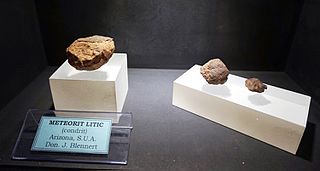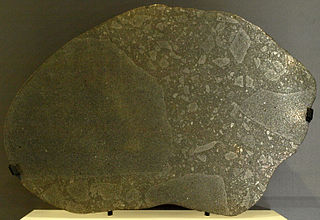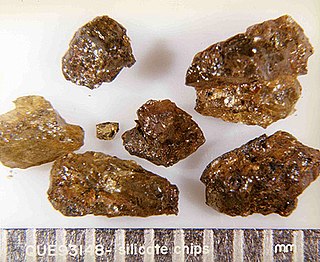
In meteoritics, a meteorite classification system attempts to group similar meteorites and allows scientists to communicate with a standardized terminology when discussing them. Meteorites are classified according to a variety of characteristics, especially mineralogical, petrological, chemical, and isotopic properties.

A chondrite is a stony (non-metallic) meteorite that has not been modified, by either melting or differentiation of the parent body. They are formed when various types of dust and small grains in the early Solar System accreted to form primitive asteroids. Some such bodies that are captured in the planet's gravity well become the most common type of meteorite by arriving on a trajectory toward the planet's surface. Estimates for their contribution to the total meteorite population vary between 85.7% and 86.2%.

An achondrite is a stony meteorite that does not contain chondrules. It consists of material similar to terrestrial basalts or plutonic rocks and has been differentiated and reprocessed to a lesser or greater degree due to melting and recrystallization on or within meteorite parent bodies. As a result, achondrites have distinct textures and mineralogies indicative of igneous processes.

Carbonaceous chondrites or C chondrites are a class of chondritic meteorites comprising at least 8 known groups and many ungrouped meteorites. They include some of the most primitive known meteorites. The C chondrites represent only a small proportion (4.6%) of meteorite falls.

The H type ordinary chondrites are the most common type of meteorite, accounting for approximately 40% of all those catalogued, 46% of the ordinary chondrites, and 44% of all chondrites. The ordinary chondrites are thought to have originated from three parent asteroids, whose fragments make up the H chondrite, L chondrite and LL chondrite groups respectively.

The L type ordinary chondrites are the second most common group of meteorites, accounting for approximately 35% of all those catalogued, and 40% of the ordinary chondrites. The ordinary chondrites are thought to have originated from three parent asteroids, with the fragments making up the H chondrite, L chondrite and LL chondrite groups respectively.

The LL chondrites are a group of stony meteorites, the least abundant group of the ordinary chondrites, accounting for about 10–11% of observed ordinary-chondrite falls and 8–9% of all meteorite falls. The ordinary chondrites are thought to have originated from three parent asteroids, with the fragments making up the H chondrite, L chondrite and LL chondrite groups respectively. The composition of the Chelyabinsk meteorite is that of a LL chondrite meteorite. The material makeup of Itokawa, the asteroid visited by the Hayabusa spacecraft which landed on it and brought particles back to Earth also proved to be type LL chondrite.

Aubrites are a group of meteorites named for Aubres, a small achondrite meteorite that fell near Nyons, France, in 1836. They are primarily composed of the orthopyroxene enstatite and are often called enstatite achondrites. Their igneous origin separates them from primitive enstatite achondrites and means they originated in an asteroid.

Enstatite chondrites are a rare form of meteorite, rich in the mineral enstatite. Only about 200 E-Type chondrites are currently known, comprising about 2% of the chondrites that fall on Earth. There are two main subtypes: EH and EL, classified based on their iron content.
CI chondrites, also called C1 chondrites or Ivuna-type carbonaceous chondrites, are a group of rare carbonaceous chondrite, a type of stony meteorite. They are named after the Ivuna meteorite, the type specimen. CI chondrites have been recovered in France, Canada, India, and Tanzania. Their overall chemical composition closely resembles the elemental composition of the Sun, more so than any other type of meteorite.

Primitive achondrites are a subdivision of meteorites. They are classified on the same rank and lying between chondrites and achondrites. They are called primitive because they are achondrites that have retained much of their original chondritic properties. Very characteristic are relic chondrules and chemical compositions close to the composition of chondrites. These observations are explained as melt residues, partial melting, or extensive recrystallization.

Lodranites are a small group of primitive achondrite meteorites that consists of meteoric iron and silicate minerals. Olivine and pyroxene make up most of the silicate minerals. Like all primitive achondrites lodranites share similarities with chondrites and achondrites.
Winonaites are a group of primitive achondrite meteorites. Like all primitive achondrites, winonaites share similarities with chondrites and achondrites. They show signs of metamorphism, partial melting, brecciation and relic chondrules. Their chemical and mineralogical composition lies between H and E chondrites.

Acapulcoites are a group of the primitive achondrite class of stony meteorites.
The Brachina meteorite is the type specimen of the brachinites class of the asteroidal achondrites.

The Zakłodzie meteorite is a stony-iron meteorite found in Poland in 1998. Its mass is 8.68 kilograms (19.1 lb). It is composed predominantly from enstatite and meteoric iron. Currently classified as an ungrouped enstatite achondrite its classification is still an ongoing scientific debate.
The Itqiy meteorite is an enstatite-rich stony-iron meteorite. It is classified as an enstatite chondrite of the EH group that was nearly melted and is therefore very unusual for that group. Other classifications have been proposed and are an ongoing scientific debate.
The Winona meteorite is a primitive achondrite meteorite. It is the type specimen and by far the largest meteorite of the winonaite group.
This is a glossary of terms used in meteoritics, the science of meteorites.
Mason Gully is an ordinary chondrite of subclass H5, and is the second meteorite to be recovered using the Desert Fireball Network (DFN) camera observatory. One stone weighing 24.5g was observed to fall by the Desert Fireball Network observatory in Western Australia on 13 April 2010 at 10h36m10s UTC. It was recovered by the DFN on 3 November 2010 by Dr. R. Merle and the Fireball network recovery team, and was found 150m from its predicted fall location based upon the observed trajectory and calculated mass.











